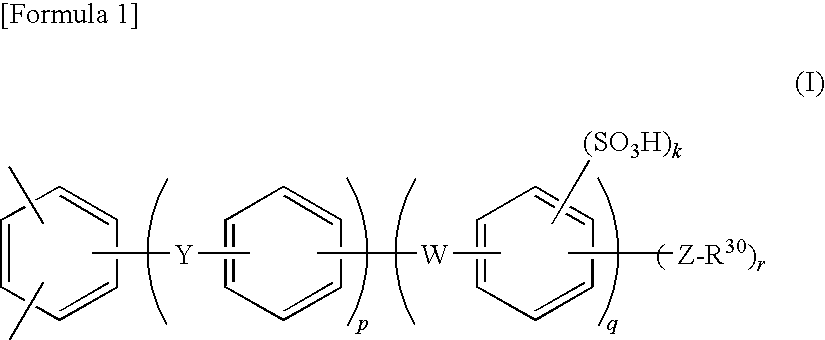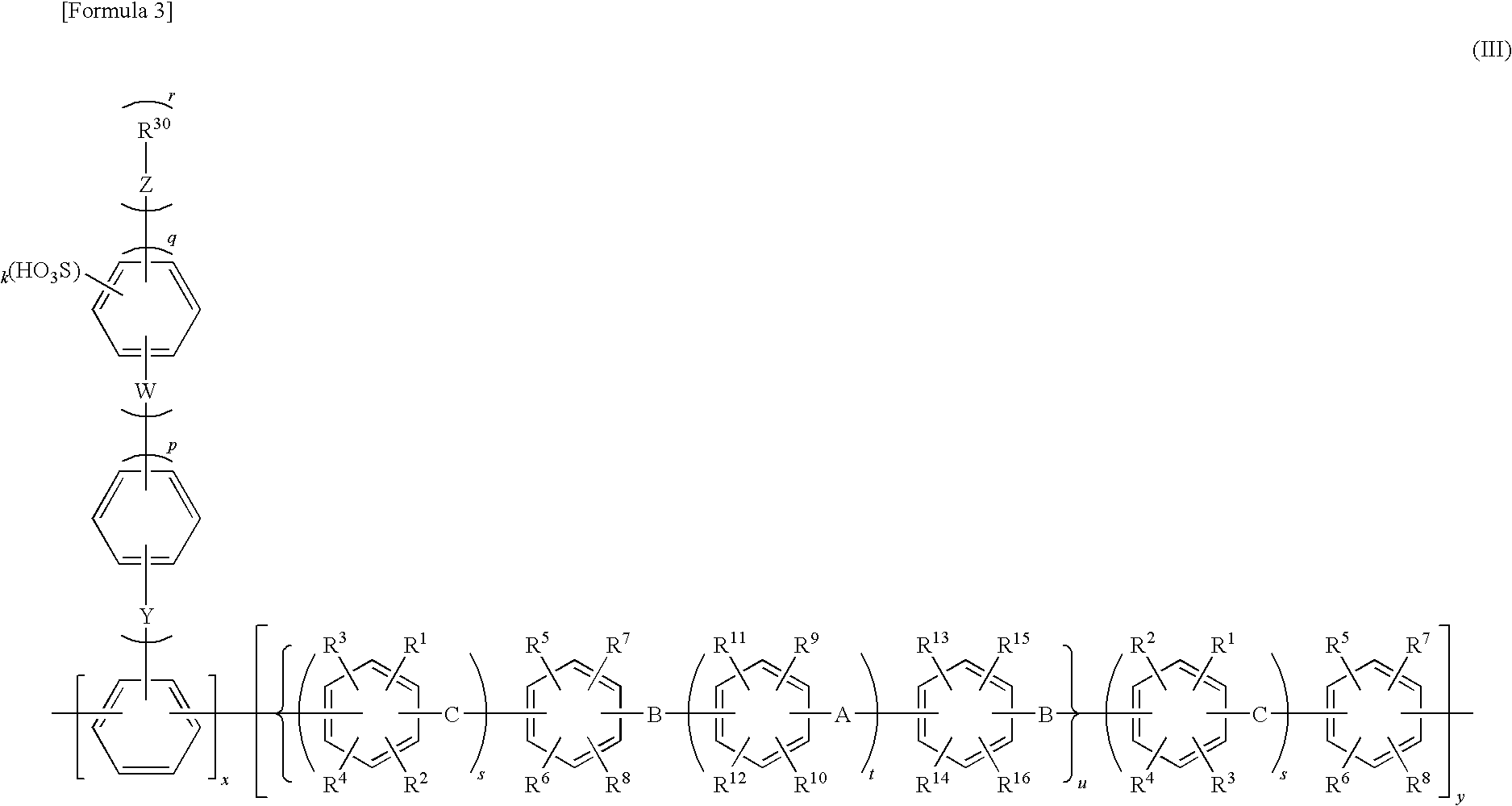Electrode electrolyte for polymer-type fuel cell, and use thereof
a fuel cell and electrolyte technology, applied in the field of electrolyte, can solve the problems of difficult reuse of expensive noble metals, such as platinum, in the electrode catalyst, and excellent proton conductivity of materials, and achieves enhanced mechanical strength, high proton conductivity, and easy recovery of catalyst metals.
- Summary
- Abstract
- Description
- Claims
- Application Information
AI Technical Summary
Benefits of technology
Problems solved by technology
Method used
Image
Examples
synthesis example 1
Synthesis of Sulfonic Acid Unit
[0136]In a 2-L three-necked flask equipped with a stirring blade, a thermometer, and a nitrogen inlet tube, 2306.4 g (24 mol) of fluorobenzene was placed and was cooled to 10° C. in an ice bath, followed by gradual addition of 1005.4 g (4.8 mol) of 2,5-dichlorobenzoyl chloride and 832.1 g (6.3 mol) of aluminum chloride, while controlling the reaction temperature not to exceed 40° C. After the addition, the mixture was stirred at 40° C. for 8 hours. After the completion of the reaction, the mixture was dropwise added to ice water, followed by extraction with ethyl acetate. After neutralization with 1% sodium hydrogen carbonate aqueous solution, the extract was washed with saturated saline, followed by concentration. Recrystallization from methanol was carried out to obtain the compound of Formula (30-1) below. The yield was 1033 g.
[0137]In a 7-L three-necked flask equipped with a stirrer, a thermometer, a cooling tube, a Dean-Stark tube, and a nitrogen ...
synthesis example 2
Synthesis of Hydrophobic Unit
[0146]In a 1-L three-necked flask equipped with a stirrer, a thermometer, a Dean-Stark tube, a nitrogen inlet tube, and a cooling tube, 154.8 g (0.9 mol) of 2,6-dichlorobenzonitrile, 269.0 g (0.8 mol) of 2,2-bis(4-hydroxyphenyl)-1,1,1,3,3,3-hexafluoropropane, and 143.7 g (1.04 mol) of potassium carbonate were weighed. After nitrogen substitution, 1020 mL of sulfolane and 510 mL of toluene were added thereto, followed by stirring. The reaction solution was heated to reflux at 150° C. in an oil bath. The water generated by the reaction was trapped with the Dean-Stark tube. After 3 hours, when substantially no generation of water was recognized, the toluene was removed to the outside of the system via the Dean-Stark tube. The reaction temperature was gradually raised to 200° C., and the stirring was continued for 3 hours, followed by addition of 51.6 g (0.3 mol) of 2,6-dichlorobenzonitrile. The reaction was further continued for 5 hours.
[0147]The reaction s...
synthesis example 3
Synthesis of Hydrophobic Unit
[0151]In a 1-L separable three-necked flask equipped with a stirring blade, a thermometer, a nitrogen inlet tube, a Dean-Stark tube, and a cooling tube, 52.4 g (240 mmol) of 4,4′-difluorobenzophenone, 14.1 g (60.0 mmol) of 4-chloro-4′-fluorobenzophenone, 70.2 g (203 mmol) of 4,4′-(1,3-phenylenediisopropylidene)bisphenol, 23.7 g (67.5 mmol) of bis(4-hydroxyphenyl)fluorene, and 48.5 g (351 mmol) of potassium carbonate were weighed, followed by addition of 430 mL of DMAc and 220 mL of toluene. The mixture was heated to reflux at 150° C. under a nitrogen atmosphere. The water generated by the reaction was removed by azeotroping with toluene via the Dean-Stark tube. After 3 hours, when substantially no generation of water was recognized, the toluene was removed to the outside of the system. The stirring was continued at 160° C. for 7 hours, followed by addition of 7.0 g (20.0 mmol) of 4-chloro-4′-fluorobenzophenone. The stirring was further continued for 3 ho...
PUM
 Login to View More
Login to View More Abstract
Description
Claims
Application Information
 Login to View More
Login to View More - R&D
- Intellectual Property
- Life Sciences
- Materials
- Tech Scout
- Unparalleled Data Quality
- Higher Quality Content
- 60% Fewer Hallucinations
Browse by: Latest US Patents, China's latest patents, Technical Efficacy Thesaurus, Application Domain, Technology Topic, Popular Technical Reports.
© 2025 PatSnap. All rights reserved.Legal|Privacy policy|Modern Slavery Act Transparency Statement|Sitemap|About US| Contact US: help@patsnap.com



